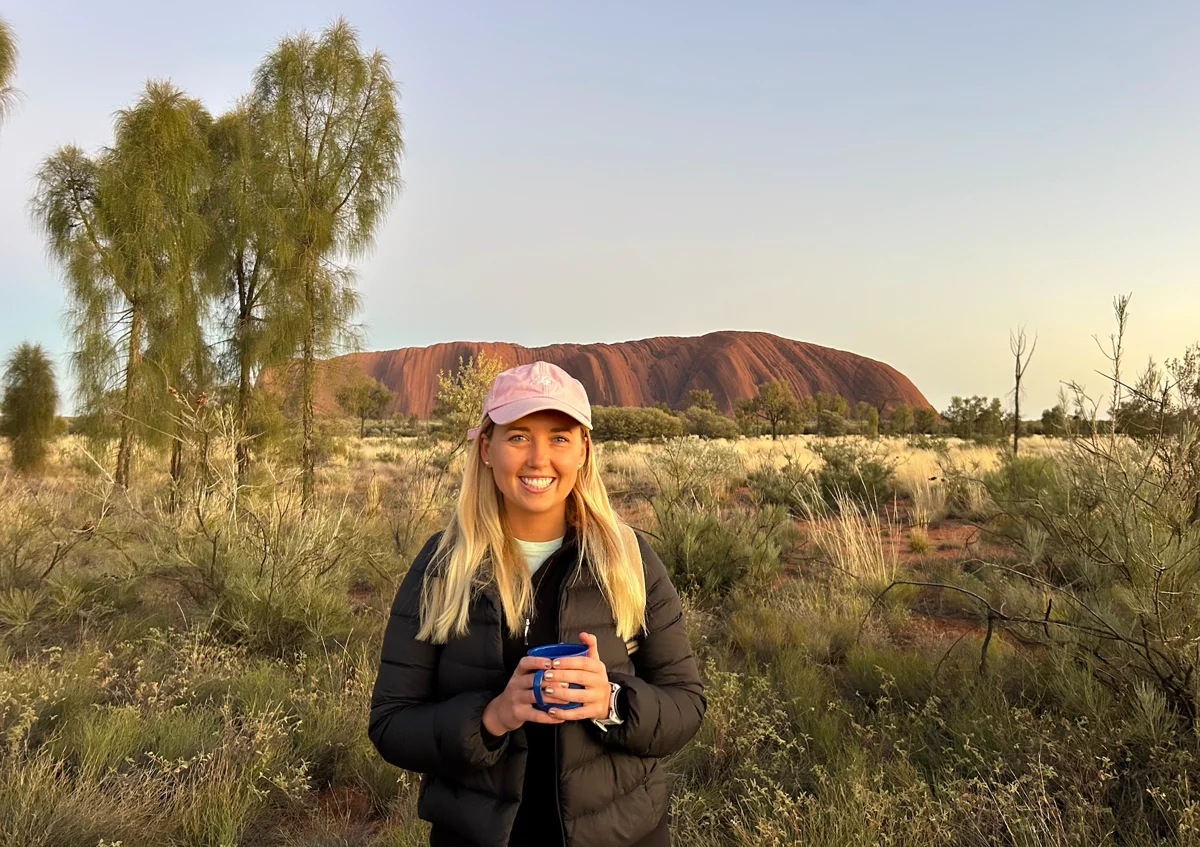Copyright standard

The story is always the same, when a friend comes back from a visit to Uluru, the “crown jewel” in Australia’s red centre. Yes, they’d seen the pictures of the sun rising behind the majestic red rock before visiting. Yes, they’d wondered what on earth could be so incredible about a rock in the middle of a dusty red desert. Then they saw it for themselves and, well, suddenly they got it. If you’re wondering what it is exactly, clearly you haven’t driven through the sunburnt heart of Australia only to be told that almighty red rock you’ve just exclaimed at isn’t Uluru, but Fooluru, the rather small doppelganger travellers often mistake for the famous monolith itself when driving along the dusty track from nearby Alice Springs. Clearly you haven’t sat curled up under a blanket sipping chai tea as the sun rises over the red desert. And you clearly haven’t seen the ancient rock art and sacred sites dotted around the rock — of course you haven’t. Because you’re not allowed to photograph them, which only adds to the magic of them when you visit the landscape for yourself. If you’re planning a visit Down Under, spending a precious couple of weeks doing a road trip up the east coast of Australia, it’s bucket list essential. Especially as this week celebrates 40 years since it was handed back to its traditional owners, the Anangu people. Yes, Sydney’s Opera House is a must — especially if you’re visiting Sydney for the Ashes this winter and want to tick off as many of the top Australian sites as you can. But the beauty of Uluru is you can be there by lunchtime (Quantas now runs direct daily flights from Sydney) and all the best bits are easily do-able in 48 hours. From mornings spent watching the sun rise over the rock to four-course sunset dinners accompanied by didgeridoo, here’s your two-night guide. The simplicity of a trip to Uluru is that almost all of the accommodation is bundled together at Ayres Rock Resort next to a funny little purpose-built town square (think gift shops and cafes), so everything you’ll need is on the doorstep and the tour buses come to you. Accommodation ranges from 2.5-star to 5 star to suit your budget: Sails in the Desert is the most luxury hotel in the resort’s collection; Emu Walk Apartments are perfect if you’re keen to cook for yourself; and Outback Lodge is the go-to for those on a budget. There’s also a campground with air-conditioned cabins, powered campsites and tent pitches for those keen to sleep out in nature. We stayed at the 4.5-star Desert Gardens Hotel — the only property in the resort to offer rooms with views of Uluru itself – and had a pleasant stay thanks to the lush gardens, decent restaurant and an on-site pool. Don’t expect luxury spas or Michelin-star dining — unless you have $4,500 in your back pocket for a night at A-list “glamping” lodge Longitude 131°, which just underwent a $2.5 million revamp and offers ultra-luxe tented pavilions with views of the rock. But you’ll be up at 4 or 5am most mornings anyway and if it’s luxury you’re after, you’re in the wrong place. In case it wasn’t obvious yet, you’re here for one thing: the rock. Yes, it can feel like Disneyland at times, with a set menu of tours and conveyor belt of perfectly manicured photo opportunities, but there’s a reason hundreds of thousands flock there every year. Choose your budget and your hotel chooses itself. Then get busy booking your tours. Wrap up warm if you’re catching the Uluru sunrise during Aussie winter (June to August) — it can get surprisingly chilly (think two puffer coats and walking boots). Sunrise Journeys, Desert Awakenings and various SEIT sunrise tours are among the most popular early-morning experiences to enjoy dawn breaking over Australia’s spiritual heart. We booked onto Sunrise Journeys — a relatively new tour from Voyages Indigenous Tourism Australia — one morning and sipped on chai tea as the desert became a canvas for a two-and-a-half-hour art experience using lasers and projections accompanied by music, soundscapes and melodic narration in local language. The indigenous-inspired, culturally-immersive projection experience launched last year — a collaboration between local Anangu artists, musicians and an expert visual experience creator — and takes place as the sun comes up over the rock. It’s quite the sight. Emu quiche is among the highlights of the breakfast that’s served once the sun is up. Morning number two was spent on SEIT’s Uluru Highlights tour, which included the opportunity to take that customary sunrise-in-front-of-the-rock photo we’ve all seen on Instagram, plus a chance to get up close and personal with the rock — an essential during any Uluru visit, whether on a tour or a self-guided walk around the base. The monolith is 348 metres tall — that’s 24 metres taller than the Eiffel Tower — a height that’s only really conceivable when you’re up close and touching it (which you can, in a couple of places). It’s also the best way to see some of Uluru’s sacred sites (make sure you read the signs — photographing most of them is banned). The highlight of SEIT’s tour was visiting Mutitjulu Waterhole, where we learned the creation stories of Liru (a venomous snake) and Kuniya (a woma python) before driving around the base of Uluru and back to our resort. It’s a light breakfast (coffee and banana bread) so don’t expect a full morning banquet, but it’s only a couple of hours long so you’ll make it back to your hotel in time for breakfast number two if you so wish. It’s a similar menu of tours for sunset, with SEIT, Voyages Indigenous Tourism Australia and others all offering an evening option to catch what is arguably one of the most breathtaking sunsets in the world. Wintjiri Wiru is one of the most popular and is essentially the evening equivalent of Sunrise Journeys: another drone and light show using the desert as a backdrop. Tali Wiru — a four-course dinner on a private dune with matching wine — is a top pick for foodies. And Field of Light combines food and art with an award-winning dinner under the stars plus a chance to walk through the Field of Light art installation by internationally acclaimed British artist Bruce Munro. We booked onto Wintjiri Wiru (meaning “beautiful view out to the horizon” in the local Pitjantjatjara language) on our first night, which just so happened to be the same evening one of Australia’s top TV channels chose to record their weather segment from the rock. Within minutes, it was easy to see why: there’s a magic about golden hour in front of the rock – especially when you’re feasting on cocktails and crocodile pie — and that’s before the sun does down and you’re invited to snuggle under your blanket, tuck into your dinner hamper and settle in for the first-ever retelling of an Indigenous tale through light and drone tech (an astounding 1,100 drones are used). Just like the morning edition Sunrise Journeys, the indigenous-inspired projection experience brings the rock and surrounding desert to life and the result is breathtaking, especially when it’s set to stories and songs that have been spoken and sung in the area for thousands of years by the Anangu people, the custodians of the land. We saw another side to Uluru’s unique and breathtaking landscape at the Field of Light experience on night two, which begins with another chance to pose for photos in front of the Uluru sunset — this time with sparkling wine and canapes before being seated with other guests at tables of 10 under the outback sky. The bushtucker-infused buffet dinner is accompanied by the didgeridoo before a stargazing workshop and a chance to wander through Bruce Munro’s Field of Light: a collection of 50,000 glass spheres glistening softly with rhythms of coloured light in an area the size of seven football fields. It’s no surprise it’s just been extended to 2027 due to high demand — it really is mesmerising. Other evening experiences include after-dark skygazing journeys, helicopter tours starting at $450 a head, and a tour out to Kata Tjuta (also known as the Olgas), the other lesser-known rock formation in the area which you can spot from the viewing platform on both the Wintjiri Wiru and Sunrise Journeys experiences. Ayers Rock Resort’s website lists them all here. Once again, it’s all about seeing as much of the rock and surrounding landscape as you can. Visitors could climb the rock until 2019, but this was banned for safety and cultural reasons after 39 people died climbing and greater awareness was given to the rock’s due cultural and spiritual significance to the Anangu people, who consider the site sacred. It’s 10km to walk all the way round, and there are segways and bikes you can hire to do the lap if you’d rather not set out on foot. Camel tours (yes, you read that correctly – Uluru is home to Australia’s largest working camel farm) are also available. Other daytime experiences include helicopter tours, didgeridoo and painting workshops, bush food and bush yarn experiences, and various film and documentary viewings — again, all bookable via Ayers Rock Resort’s site, and many of them free for visitors. SEIT also has a range of daytime experiences, from day trips to the traditional Aboriginal homelands at Cave Hill, to a four-wheel drive adventure to Mount Conner, which is located on a privately owned cattle station. Otherwise, most tourists opt to nap, chill or mooch around the hotel and town square to recover from the early alarm. The Gallery of Central Australia is well worth a visit (the dot paintings are mesmerising, and 60 per cent of profits go back to the artists) and Voyages Indigenous Tourism Australia also runs a new Australian Native High Tea experience, which is proving popular with foodies. I popped out for a 5k jog to a couple of lookouts close to the hotel (make sure you stick to the paths — it’s snake territory) and friends highly recommend running the 10k loop around the rock if you have access to a car (most hotels are 20km from the rock). It’s possible to hire your own car and give yourself a little more flexibility during your stay. But most visitors don’t bother — they just book onto plenty of tours and join the bus brigade like we did. The upside is you can say yes to the (many) drinks you’re offered during the tours. Uluru is an essential on the Australia tourist trail, whatever the time of year, but be warned that desert temperatures can get as high as 47 degrees in the months between December and February and fly-nets are an essential for most of the year (see: any selfie taken between September and April). Don’t say you weren’t warned. We visited in August, Aussie winter, and temperatures ranged from freezing first thing in the morning (yes, I lost the feeling in my toes even in thick socks and walking boots) to the early twenties at lunch, so the two puffer coats my boyfriend teased me for packing were just as welcome as the bikinis I needed by midday. The best bit? No flies. Aboriginal Australians are the oldest living culture in the world. Each of the country’s 250 NATIONS has its own cultural practices, protocols, language, law, ceremonial songs, and dances (Uluru is part of Uluru-Kata Tjuta National Park, home to the Anangu people) — so be respectful and read-up before you go. Advice for visitors includes dressing respectfully (no crop tops, please), seeking permission from the Aboriginal Traditional Owners before going anywhere ‘off track’, and asking for the consent of the person or people before taking their photo. Curiosity is encouraged — it shows appreciation and a willingness to learn — but be aware that knowledge is considered an inheritance in indigenous culture. You have to earn the right to it, so even your tour guides are likely not to have the authority to share every single one of the stories. Katie was a guest of Tourism NT (Northern Territory) and Desert Gardens Hotel, northernterritory.com, ayersrockresort.com.au



